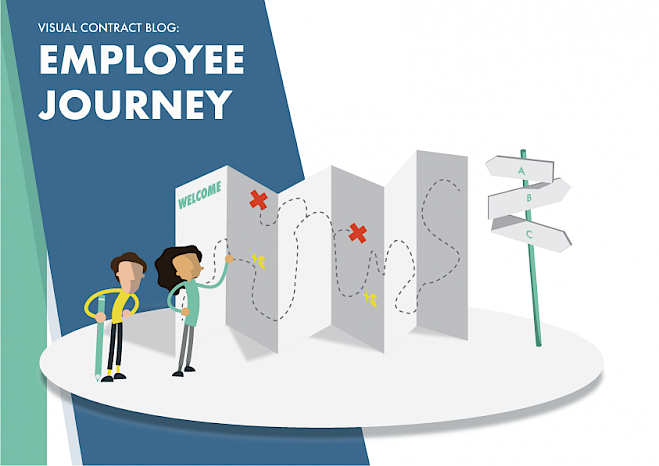How mapping your employee journey will help you optimize your employer branding.
About the importance of employee touchpoints,
including visual employment contracts
Employer branding. Everybody is talking about it. But what does it really mean? Is it how you, as a company, are perceived by the outside world? Is it about your logo? Or all the benefits that come with working at your place?
Well, it is definitely about the reputation of your company. About making sure that your company is the preferred employer in your field of expertise. To attract but also retain the right people for your business. Ideally your business should create a position for itself that is authentic and distinctive. What makes your company the place to work? You will need to be able to tell a credible and honest story. A story that you can back up, in order to attract but also retain the right people. The people that will help you achieve your business goals. Your mission and vision must be plausible, and visible throughout everything your business does and represents. So, how exactly can you create an employer brand that truly represents your company’s mission and vision? An employer brand that is credible and realistic.
This is where the importance of your employee journey enters the scene. Only by truly understanding your employee journey and, therefore, your employees, will you be able to create an employer brand that is perceived as honest, and will it deliver the results you’re after: building sustainable working relationships with employees to achieve your business objectives, but also to create a happy working environment for those that make your business tick. Happy employees are the best way to advertise and promote your company.
A great starting point to get to grips with and fully understand your employee journey and employees, is a combination of design research methods like observations, deep interviews (intensive individual interviews), generative sessions where participants share their experiences, and employment engagement surveys - all going straight to the source: your employees. This enables you to identify and recognize any underlying needs.
Let’s have a closer look at what the touchpoints throughout an employee journey are. Where does it start? And how could visual employment contracts play an important part in this?
Crucial moments are the actual start of employment - the day you first start working for a company, but also the day you leave, or when you get promoted. All these crucial moments are closely related to your employment contract. Your contract documents all terms and conditions, including your secondary terms like number of holiday and other benefits.
An employment contract should be the basis of a sustainable working relationship. Therefore, it is also an important touchpoint within your employee journey, and part of your employer branding. It should clearly communicate all those terms, conditions and benefits that make your company the place where people want to work. From traditional terms and benefits like salary and number of holiday to offering flexibility when it comes to working from home, and creating a healthy work-life balance. Your employment contract is, in effect, a mini employee journey - from receiving and reading, to negotiating and signing - representing a sustainable working relationship.

So, why is mapping an employee journey important?
It will give us a realistic view of what the company really stands for, how it is perceived by its employees. It will enable us to create a credible employer brand that will attract and retain the best employees. Furthermore, it will give us an insight into what can be improved, and ideas as to how to improve the employee journey. This will allow us to start creating a prototype for an improved employee journey, including a visual employment contract.
For Visual Contracts, this would be creating a prototype of a visual employment contract that reflects the ultimate employee journey, incorporating consistent employer branding. Employer branding that in turn clearly and credibly reflects what the company stands for. This is a process we also followed with CSU. Want to read more about this, click here (insert link to CSU case).
We look at how employment contracts are used throughout an entire employee journey. How visual employment contracts can help build a sustainable working relationship based on trust. Creating a healthy power of balance amongst all parties involved - from HR and legal to employees
We also look at how the employee experience - and all its touchpoints - can be clearly reflected within the contract. How the document influences the relationship, and the role it plays within the whole journey: position opening, recruiting candidates, drafting offer, contract negotiation, signing the contract, onboarding, performance reviews, and end/renewal of contract.
As you can see, an employment contract is omnipresent during an employee journey. It forms the basis of a sustainable working relationship. Therefore, it is essential that it communicates the right tone of voice, represents the objectives and expectations of both employer and employee. That it is a true representation of the employer brand - in order to attract and retain the right talent, telling a credible and true story. A story that is clear and easy to understand - visually and textually. That’s exactly what we do at Visual Contracts, and we would love to chat some more about it, with you.
